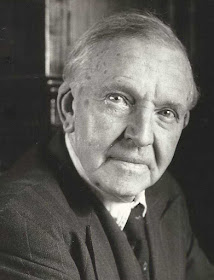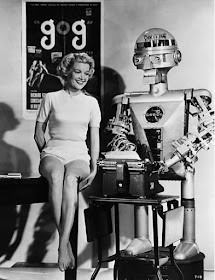The idea of robot reporters
has been around a very long time, 85 years to be precise. But what John
Coatman* (1889-1958), professor of Imperial Economic Relations at the University of London, had
in mind when he was appointed news editor of the British Broadcasting
Corporation in 1934 was very different from the alarming news Jaclyn Peiser
reported in the media section of yesterday’s The New York Times, under the
headline “The Rise of Robot Reporters”. The Coatman robot wasn’t expected to be
able to think for itself; Peiser wrote about artificial intelligence now being used
in reporting.
John Coatman
Coatman’s plan was to add a
metallic “reporter” to his staff – he also appointed the BBC’s first two
professional journalists, who happily happened to be humans. Coatman had
decided to send his robot to political meetings, first nights at the theatre,
public dinners and boxing and football matches. Its sensitive recording device
would pick up “raw news” to be broadcast on BBC radio. Presumably the BBC
thought Coatman was quite mad, because it didn’t proceed with the idea.
Given Coatman’s dubious qualifications for the job – sadly he
was a precursor for the people who are making decisions for the worldwide media
today - his thinking was based on economics. His Tin Man reporter might need an
occasional drop of oil, but it would save the BBC having to pay a weekly salary to
feed some living-breathing reporter's wife and kids and put a roof over the head of the flesh-and-blood journo.
"Robot" machines in the Press Box on fight night.
Coatman wasn’t the first to think of the idea of a robot
reporter, simply the first to seriously propose such a monstrosity. Six years
earlier, when the great American newspaper publisher Frank Ernest Gannett
(1876-1957) demonstrated Walter Welcome Morey’s robotic typesetting machines to
news industry leaders in Rochester, New York, he was asked whether the
automation of Linotypes could be extended to a “mechanical substitute for
reporters”. The journalist covering the event for Associated Press thought the question was “facetious”. Gannett’s technology was actually the Teletypesetter,
a device for setting type by telegraph developed with Morkrum-Kleinschmidt in
Chicago and ultimately dependent on human input (and outtake).
The
horrid vision of robot reporters had been around since at least 1924, when US
journalist and political theorist Frank Richardson Kent I (1877-1958) was asked
about his insightful interviewing style. "His" interviewing technique would remain in vogue, Kent said, until such time as the unthinkable happened and newspaper and magazine publishers replaced human beings with robot reporters. It took another 67 years before the
nightmare became a reality, when Nihon Visual in Tokyo launched its $US7
million Stherotina (or “Tina” for short), a 5ft tall, 99lb kimono-clad beauty
who could interview robot dancers at Tokushima on Shikoku. Apparently they
understood one another’s language.
By
2002 the world was gripped by MIT’s idea that Mars Explorer-type robots could
report in war zones. Not only would the reporter not ask for wages, but it
wouldn’t take sick leave and wouldn’t die on the job expecting to be buried at
some expensive funeral. Costly blood would not be spilt in the quest for news.
Robotic reporting is now a reality, even here, where The
Guardian’s Australian edition published its first machine-assisted article
last week. And the world is worse for it. How are these machines programmed,
and who’s in control of programming them? Can they really THINK for themselves? I doubt it. A New Zealand journalist
pointed out today, “There are quite severe limitations with auto-stories. For
example Motley Fool (presumably using a human reporter) reported that MicroStrategy’s
‘Revenue declined once again, and adjusted earnings fell off a cliff’. A
preformatted automated story won’t spot the unexpected - which is where
the news is.” As Peiser reported, AP’s straightforward robot written story
said, “MicroStrategy … reported fourth-quarter net income of $3.3 million,
after reporting a loss in the same period a year earlier.”
The
worst part of all this is, as Coatman foresaw 85 years ago in London, robot reporters
save publishers and broadcasters money. Right now in Australia, private equity owners such as Allegro
Funds, Anchorage Capital and Platinum Equity, organisations which know nothing
about the industry, are lining up to carve up “regional” (Australian Community
Media division) newspapers not wanted by the Nine Network (Nine Entertainment),
which took over Fairfax Media last year. These people have no interest other
than the extraction of money, and their civic responsibility is limited to a
blank stare. “Hedge funds buy old media not to save them, but to milk them,”
reported Crikey.com. “Old media may have a limited life, but they have revenues
to be milked all the way to the end. To maximise profit on revenues, they gut
cost-centres - or ‘newsrooms’ as we used to call them.” Yes, they gut them of
humans and replace bodies with robots.
Investment
bank Macquarie Capital has the mandate to divest the “regional” newspapers,
more than 170 publications and related websites which include key mastheads
such as The Canberra Times, The Newcastle Herald, The Border Mail and Illawarra Mercury. Many of the publications mentioned on the right of the
graphic above have, in my 50 years’ experience in Australian newspapers, proved
to be the breeding ground of some of this country’s finest human journalists.
*John Coatman was born in Stockport, Cheshire, England, in the last quarter of 1889. He was educated at Manchester Grammar School and Manchester University and went on to Pembroke College, Oxford University. In 1910 he joined the Indian Police Force and served in the Frontier Constabulary from 1914-19 and in the third Afghan War. In 1926 he became director of public information for the Indian Government and was a member of the Legislative Assembly from that year until 1930, when he returned to England and took up his position as professor of Imperial Economic Relations at the University of London. He died at Murcott, Oxfordshire, on November 1, 1958, aged 68.









What's he world coming to? Are we moving from Fake News to Artificial News? Have mercy on our souls.
ReplyDeleteI’ll need to get a robot reader!
ReplyDeleteThe world needs journalists more than it ever has before. Even when it comes to reporting the scores of games — as you well know!
ReplyDeleteI think robots could do better than many of today's reporters. We need more of the old hard core cigar chomping fellows who could really ferret out a good story and report it objectively and truthfully rather than the sensationalist spin folks we have these days.
ReplyDeleteFirst time I ever saw the brass pounders in the press box. The original digital mode of communication.
Fascinating!
ReplyDeleteMay I ask where you found the image of John Coatman? I would like to use an image of him for my own site (on a quite different topic, namely his involvement in the Round Table Conferences), and have so far been unsuccessful. Any help you can give would be much appreciated!